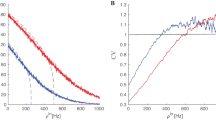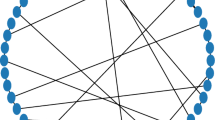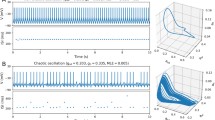Abstract
For studying how dynamical responses to external stimuli depend on the synaptic-coupling type, we consider two types of excitatory and inhibitory synchronization (i.e., synchronization via synaptic excitation and inhibition) in complex small-world networks of excitatory regular spiking (RS) pyramidal neurons and inhibitory fast spiking (FS) interneurons. For both cases of excitatory and inhibitory synchronization, effects of synaptic couplings on dynamical responses to external time-periodic stimuli S(t) (applied to a fraction of neurons) are investigated by varying the driving amplitude A of S(t). Stimulated neurons are phase-locked to external stimuli for both cases of excitatory and inhibitory couplings. On the other hand, the stimulation effect on non-stimulated neurons depends on the type of synaptic coupling. The external stimulus S(t) makes a constructive effect on excitatory non-stimulated RS neurons (i.e., it causes external phase lockings in the non-stimulated sub-population), while S(t) makes a destructive effect on inhibitory non-stimulated FS interneurons (i.e., it breaks up original inhibitory synchronization in the non-stimulated sub-population). As results of these different effects of S(t), the type and degree of dynamical response (e.g., synchronization enhancement or suppression), characterized by the dynamical response factor \(D_f\) (given by the ratio of synchronization degree in the presence and absence of stimulus), are found to vary in a distinctly different way, depending on the synaptic-coupling type. Furthermore, we also measure the matching degree between the dynamics of the two sub-populations of stimulated and non-stimulated neurons in terms of a “cross-correlation” measure \(M_c\). With increasing A, based on \(M_c\), we discuss the cross-correlations between the two sub-populations, affecting the dynamical responses to S(t).






Similar content being viewed by others
References
Batista CAS, Batista AM, de Pontes JAC, Viana RL, Lopes SR (2007) Chaotic phase synchronization in scale-free networks of bursting neuron. Phys Rev E 76:016218
Batista CAS, Lopes SR, Viana RL, Batista AM (2010) Delayed feedback control of bursting synchronization in a scale-free neuronal network. Neural Netw 23:114–124
Batista CAS, Viana RL, Ferrari FAS, Lopes SR, Batista AM, Coninck JCP (2013) Control of bursting synchronization in networks of Hodgkin–Huxley-type neurons with chemical synapses. Phys Rev E 87:042713
Benabid AL, Chabardes S, Mitrofanis J, Pollak P (2009) Deep brain stimulation of the subthalamic nucleus for the treatment of Parkinson’s disease. Lancet Neurol 8:67–81
Brunel N, Hakim V (2008) Sparsely synchronized neuronal oscillations. Chaos 18:015113
Brunel N, Wang XJ (2003) What determines the frequency of fast network oscillations with irregular neural discharges? I. Synaptic dynamics and excitation-inhibition balance. J Neurophysiol 90:415–430
Bullmore E, Sporns O (2009) Complex brain networks: graph-theoretical analysis of structural and functional systems. Nat Rev Neurosci 10:186198
Buzsáki G (2006) Rhythms of the brain. Oxford University Press, New York
Buzsáki G, Geisler C, Henze DA, Wang XJ (2004) Interneuron diversity series: circuit complexity and axon wiring economy of cortical interneurons. Trends Neurosci 27:186–193
Golomb D, Rinzel J (1994) Clustering in globally coupled inhibitory neurons. Phys D 72:259–282
Gray CM (1994) Synchronous oscillations in neuronal systems: mechanisms and functions. J Comput Neurosci 1:11–38
Gu H, Pan B (2015) A four-dimensional neuronal model to describe the complex nonlinear dynamics observed in the firing patterns of a sciatic nerve chronic constriction injury model. Nonlinear Dyn 81:2107–2126
Gu H, Pan B, Chen G, Duan L (2014) Biological experimental demonstration of bifurcations from bursting to spiking predicted by theoretical models. Nonlinear Dyn 78:391–407
Guare J (1990) Six degrees of separation: a play. Random House, New York
Hamani C, Neimat J, Lozano AM (2006) Deep brain stimulation for the treatment of Parkinson’s disease. J Neural Transm Suppl 70:393–399
Hammond C, Bergman H, Brown P (2007) Pathological synchronization in Parkinson’s disease: networks, models and treatments. Trends Neurosci 30:357–364
Hodgkin AL (1948) The local electric changes associated with repetitive action in a non-medullated axon. J Physiol 107:165–181
Ivanchenko MV, Osipov GV, Shalfeev VD, Kurths J (2004) Phase synchronization in ensembles of bursting oscillators. Phys Rev Lett 93:134101
Izhikevich EM (2000) Neural excitability, spiking and bursting. Int J Bifurc Chaos 10:1171–1266
Izhikevich EM (2003) Simple model of spiking neurons. IEEE Trans Neural Netw 14:1569–1572
Izhikevich EM (2004) Which model to use for cortical spiking neurons? IEEE Trans Neural Netw 15:1063–1070
Izhikevich EM (2007) Dynamical systems in neuroscience. MIT Press, Cambridge
Izhikevich EM (2010) Hybrid spiking models. Philos Trans R Soc A 368:5061–5070
Joris PX, Carney LH, Simith PH, Yin TCT (1994) Enhacement of neural synchronization in the anteroventral cochlear nucleus. I. Responses to tones at the characteristic frequency. J Neurophysiol 71:1022–1036
Kim SY, Lim W (2013) Coupling-induced population synchronization in an excitatory population of subthreshold Izhikevich neurons. Cogn Neurodyn 7:495–503
Kim SY, Lim W (2014) Realistic thermodynamic and statistical-mechanical measures for neural synchronization. J Neurosci Methods 226:161–170
Kim SY, Lim W (2015a) Noise-induced burst and spike synchronizations in an inhibitory small-world network of subthreshold bursting neurons. Cogn Neurodyn 9:179–200
Kim SY, Lim W (2015b) Effect of small-world connectivity on fast sparsely synchronized cortical rhythms. Phys A 421:109–123
Kim SY, Kim Y, Hong DG, Kim J, Lim W (2012) Stochastic bursting synchronization in a population of subthreshold Izhikevich neurons. J Korean Phys Soc 60:1441–1447
Lim W, Kim SY (2007) Characterization of stochastic spiking coherence in coupled neurons. J Korean Phys Soc 51:1427–1431
Lim W, Kim SY (2011) Statistical-mechanical measure of stochastic spiking coherence in a population of inhibitory subthreshold neuron. J Comput Neurosci 31:667–677
Longtin A (1995) Synchronization of the stochastic Fitzhugh–Nagumo equations to periodic forcing. Nuovo Cimento D 17:835–846
Longtin A (2000) Stochastic aspects of neural phase locking to periodic signals. In: Kim S, Lee KJ, Sung W (eds) Stochastic dynamics and pattern formation in biological and complex systems. AIP, New York, pp 219–239
Lv M, Ma J (2016) Multiple modes of electrical activities in a new neuron model under electromagnetic radiation. Neurocomputing 205:375–381
Lv M, Wang C, Ren G, Ma J (2016) Model of electrical activity in a neuron under magnetic flow effect. Nonlinear Dyn 85:1479–1490
Mathewson KE, Prudhomme C, Fabiani M, Beck DM, Lleras A, Gratton G (2012) Making waves in the stream of consciousness: entraining oscillations in EEG alpha and fluctuations in visual awareness with rhythmic visual stimulation. J Cogn Neurosci 24:2321–2333
Milgram S (1967) The small world problem. Psychol Today 1:61–67
Milton J, Jung P (eds) (2003) Epilepsy as a dynamic disease. Springer, Berlin
Press WH, Teukolsky SA, Vetterling WT, Flannery BP (1992) Numerical recipes in C: the art of scientific computing, 2nd edn. Cambridge University Press, New York
Rosenblum MG, Pikovsky AS (2004a) Controlling synchronization in an ensemble of globally coupled oscillators. Phys Rev Lett 92:114102
Rosenblum MG, Pikovsky AS (2004b) Delayed feedback control of collective synchrony: an approach to suppression of pathological brain rhythms. Phys Rev E 70:041904
San Miguel M, Toral R (2000) Stochastic effects in physical systems. In: Martinez J, Tiemann R, Tirapegui E (eds) Instabilities and nonequilibrium structures VI. Kluwer Academic Publisher, Dordrecht, pp 35–130
Shimazaki H, Shinomoto S (2010) Kernel bandwidth optimization in spike rate estimation. J Comput Neurosci 29:171–182
Sporns O (2011) Netw brain. MIT Press, Cambridge
Strogatz SH (2001) Exploring complex networks. Nature 410:268–276
Traub RD, Whittington MA (2010) Cortical oscillations in health and diseases. Oxford University Press, New York
Uhlhaas PJ, Singer W (2006) Neural synchrony in brain disorders: relevance for cognitive dysfunctions and pathophysiology. Neuron 52:155–168
Viana RL, Batista AM, Batista CAS, de Pontes JCA, dos S Silva FA, Lopes SR (2012) Bursting synchronization in networks with long-range coupling mediated by a diffusing chemical substance. Commun Nonlinear Sci Numer Simul 17:2924–2942
Wang XJ (2003) Neural oscillations. In: Nadel L (ed) Encyclopedia of cognitive science. MacMillan, London, pp 272–280
Wang XJ (2010) Neurophysiological and computational principles of cortical rhythms in cognition. Physiol Rev 90:1195–1268
Watts DJ (2003) Small worlds: the dynamics of networks between order and randomness. Princeton University Press, Princeton
Watts DJ, Strogatz SH (1998) Collective dynamics of small-world networks. Nature 393:440–442
Will U, Berg E (2007) Brain wave synchronization and entrainment to periodic acoustic stimuli. Neurosci Lett 424:55–60
Acknowledgements
This research was supported by the Basic Science Research Program through the National Research Foundation of Korea (NRF) funded by the Ministry of Education (Grant No. 20162007688).
Author information
Authors and Affiliations
Corresponding author
Appendix: Statistical-mechanical spiking measure in the stimulated and the non-stimulated sub-populations
Appendix: Statistical-mechanical spiking measure in the stimulated and the non-stimulated sub-populations
We measure the degree of population synchronization in each of the stimulated and the non-stimulated sub-populations in terms of a realistic statistical-mechanical spiking measure, based on the ISPSR kernel estimate \(R_s^{(l)}(t)\) (\(l=1\) and 2 correspond to the stimulated and the non-stimulated cases, respectively) (Kim and Lim 2014). Population synchronization may be well visualized in the raster plot of spikes. For a synchronized case, spiking stripes or bursting bands (indicating population synchronization) appear successively in the raster plot, and the corresponding ISPSR kernel estimate \(R_s^{(l)}(t)\) exhibits a regular oscillation. Each ith (\(i=1,2,3,\ldots \)) global cycle of \(R_s^{(l)}(t)\) begins from its left minimum, passes the central maximum, and ends at the right minimum [also, corresponding to the beginning point of the next \((i+1)\)th global cycle]; the 1st global cycle of \(R_s^{(l)}(t)\) appears after transient times of \(10^3\,\hbox {ms}\). Spikes which appear in the ith global cycle of \(R_s^{(l)}(t)\) forms the ith stripe/band in the raster plot. To measure the degree of population synchronization in each of the stimulated (\(l=1\)) and the non-stimulated (\(l=2\)) sub-populations, a statistical-mechanical measure \(M_s^{(l)}\), based on \(R_s^{(l)}(t)\), was introduced by considering the occupation pattern and the pacing pattern of spikes in the stripes/bands (Kim and Lim 2014). The spiking measures \(M_i^{(l)}\) of the ith stripe/band [appearing in the ith global cycle of \(R_s^{(l)}(t)\)] is defined by the product of the occupation degree \(O_i^{(l)}\) of spikes (representing the density of the ith stripe/band) and the pacing degree \(P_i^{(l)}\) of spikes (denoting the smearing of the ith stripe/band):
The occupation degrees \(O_i^{(l)}\) in the ith stripe/band is given by the fractions of spiking neurons in the ith stripe/band:
where \(N_{i}^{(l)}\) is the number of spiking neurons in the ith stripe/band. For full synchronization with fully-occupied stripes/bands, \(O_i^{(l)} = 1\), while for sparse synchronization with partially-occupied stripes/bands, \(O_i^{(l)} < 1\). The pacing degree \(P_i^{(l)}\) of spikes in the ith stripe/band can be determined in a statistical-mechanical way by taking into account their contributions to the macroscopic ISPSR kernel estimate \(R_s^{(l)}(t)\). An instantaneous global phase \(\varPhi ^{(l)}(t)\) of \(R_s^{(l)}(t)\) was introduced via linear interpolation in the two successive subregions forming global cycles (Kim and Lim 2014). The global phase \(\varPhi ^{(l)}(t)\) between the left minimum (corresponding to the beginning point of the ith global cycle) and the central maximum is given by
and \(\varPhi ^{(l)}(t)\) between the central maximum and the right minimum [corresponding to the beginning point of the \((i+1)\)th global cycle] is given by
where \(t_{i}^{(l,min)}\) is the beginning time of the ith (\(i=1, 2, 3, \ldots \)) global cycle of \(R_s^{(l)}(t)\) [i.e., the time at which the left minimum of \(R_s^{(l)}(t)\) appears in the ith global cycle], and \(t_{i}^{(l,max)}\) is the time at which the maximum of \(R_s^{(l)}(t)\) appears in the ith global cycle. Then, the contributions of the kth microscopic spikes in the ith stripe/band occurring at the times \(t_{k}^{(l)}\) to \(R_s^{(l)}(t)\) is given by \(\cos \varPhi _k^{(l)}\), where \(\varPhi _k^{(l)}\) are the global phases at the kth spiking time [i.e., \(\varPhi _k^{(l)} \equiv \varPhi ^{(l)}(t_{k}^{(l)})\)]. Microscopic spikes make the most constructive (in-phase) contributions to \(R_s^{(l)}(t)\) when the corresponding global phases \(\varPhi _k^{(l)}\) is \(2 \pi n\) (\(n=0,1,2, \ldots \)), while they make the most destructive (anti-phase) contribution to \(R_s^{(l)}(t)\) when \(\varPhi _k^{(l)}\) is \(2 \pi (n-1/2)\). By averaging the contributions of all microscopic spikes in the ith stripe/band to \(R_s^{(l)}(t)\), we obtain the pacing degrees \(P_i^{(l)}\) of spikes in the ith stripe/band:
where \(S_i^{(l)}\) is the total number of microscopic spikes in the ith stripe/band. By averaging \(M_i^{(l)}\) of Eq. (14) over a sufficiently large number \(N_s^{(l)}\) of stripes/bands, we obtain the statistical-mechanical spiking measure \(M_s^{(l)}\):
Here, we follow \(3 \times 10^3\) global cycles in each realization, and obtain the average occupation degree, the average pacing degree, and the average statistical-mechanical spiking measure via average over 30 (60) realizations for the case of the non-stimulated (stimulated) sub-population. Here, more realizations are necessary for the stimulated case because the number \(N_s ({=}50)\) of stimulated neurons is much less than that (\({=}950\)) of non-stimulated neurons.
Rights and permissions
About this article
Cite this article
Kim, SY., Lim, W. Dynamical responses to external stimuli for both cases of excitatory and inhibitory synchronization in a complex neuronal network. Cogn Neurodyn 11, 395–413 (2017). https://doi.org/10.1007/s11571-017-9441-5
Received:
Revised:
Accepted:
Published:
Issue Date:
DOI: https://doi.org/10.1007/s11571-017-9441-5




